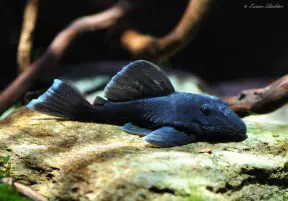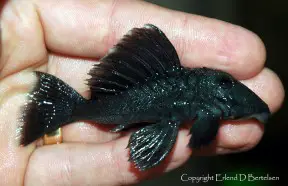Baryancistrus beggini
L239, Blue 'Panaque'
Etymology
Baryancistrus: from the Greek βαρύς (barys), meaning ‘heavy’, and the generic name Ancistrus.
beggini: named in honour of Chris Beggin for ‘his financial support of this research, ethical ornamental fish business practices, and influence on the professional development of the first author’.
Classification
Order: Siluriformes Family: Loricariidae
Distribution
Known only from the area around the confluence of the río Ventauri with the río Orinoco in Amazonas state, Venezuela, plus the lower río Guaviare, Colombia, which flows into the Orinoco a little further south.
Habitat
The type series was collected from spaces between granite bedrock and boulders.
Other loricariid species inhabiting the area around the confluence of the Ventauri and Orinoco include Acanthicus hystrix, Ancistrus macrophthalmus, Baryancistrus demantoides, Hemiancistrus subviridis, Hemiancistrus guahiborum, Hypancistrus contradens, Hypancistrus debilittera, Hypancistrus furunculus, Hypancistrus lunaorum, Lasiancistrus schomburgkii, Leporacanthicus galaxias, Leporacanthicus triactis, Panaque nigrolineatus, Peckoltia vittata, Pseudancistrus orinoco, Pseudancistrus pectegenitor, Pseudancistrus sidereus, Pseudolithoxus anthrax, Pseudolithoxus dumus, and Pseudolithoxus tigris.
Maximum Standard Length
The largest specimen in the type series measured 80.9 mm.
Aquarium SizeTop ↑
An aquarium with base dimensions of 80 ∗ 30 cm or equivalent should be the smallest considered for long-term maintenance.
Maintenance
Not difficult to maintain under the correct conditions but largely unsuitable for the ‘general’ community aquarium.
The ideal set-up should be designed to resemble a flowing river with a substrate of variably-sized rocks, gravel and some large water-worn boulders.
This can be further furnished with driftwood branches, roots and tough aquatic plants such as Microsorum, Bolbitis, or Anubias spp., which can be grown attached to the décor, while bright lighting will promote the growth of aufwuchs upon which the fish will graze.
Like many species that naturally inhabit running waters it’s intolerant to the accumulation of organic wastes and requires spotless water at all times in order to thrive.
It’s also essential to provide sufficient levels of dissolved oxygen and water movement using a combination of canister filters, powerheads, etc., particularly if the aim is for the fish to breed, and weekly water changes of 40-70% should also be considered mandatory.
Water Conditions
Temperature: 26 – 30 °C
pH: 5.5 – 7.5
Hardness: 18 – 179 ppm
Diet
Gut analyses of wild specimens revealed the diet to be composed chiefly of periphyton and associated microorganisms, meaning this species is not as herbivorous as some other members of the genus (see ‘Notes’).
In the aquarium aufwuchs should be allowed to colonise all surfaces except the viewing pane so that the fish can browse naturally although the diet should of course be supplemented with high-quality sinking dried foods (preferably with added vegetable content), live or frozen bloodworm, mosquito larvae and similar, plus the occasional defrosted prawn or shrimp.
Home-made, gelatine-bound recipes containing a mixture of puréed fish food, shellfish, fruit and vegetables, are also proven to work well and in many ways represent the ideal staple diet since the ingredients can be altered at will.
When made well such foods contain a greater concentration and diversity of nutrients than any of the other options.
Baryancistrus spp. are often under-nourished and/or suffering from health issues post-importation and may require an extended period of quarantine and acclimatisation.
They also have a relatively high metabolic rate and may require several meals per day during the initial period.
Behaviour and CompatibilityTop ↑
Relatively peaceful but not recommended for the ‘general’ community aquarium due to its somewhat delicate nature.
Keep it alone or perhaps alongside some small characids that will not compete with it for food or territory.
It’s territorial with conspecifics and similar-looking species, with this behaviour being particularly pronounced among males, but due to its small size several can be kept together in many cases.
Sexual Dimorphism
Adult males develop relatively longer odontotes on the opercles and pectoral-fin spines, and possibly display a greater degree of blue pigmentation than females.
Sexually-mature females are slightly wider-bodied than males, this being more noticeable when gravid.
Reproduction
Cave spawner. The female is ejected post-spawning and the male guards and tends the eggs.
NotesTop ↑
Prior to description this species was traded under the L-number L239.
It can be distinguished from other species in the genus and other hypostomines (see below for definition of this grouping) by its uniformly black to brownish body and fin colouration with a turquoise to bluish sheen, and the acutely bent shape of midventral body plates 3-5 which form a distinctive keel running along the body, above the pectoral fins.
Placement in Baryancistrus can only be considered tentative, however, since it exhibits several notable differences to other members of the grouping.
This was noted by Lujan et al. in its description and it may be moved elsewhere in the future, pending results of more detailed comparative studies between related species.
The genus Baryancistrus can be distinguished from all other loricariids by possession of an enlarged membrane located posteriorly to the last branched dorsal-fin ray.
This membrane may or may not reach the supporting structure of the adipose fin (it does so in B. beggini) and in this way members can be told apart from the genera Oligancistrus, Parancistrus, and Spectracanthicus, in which the dorsal and adipose fins are completely connected, and Hemiancistrus in which the membrane is not well-developed.
The family Loricariidae is the largest among catfishes with over 700 species described to date and many awaiting description.
The latter are typically assigned a specific ‘L’ number by hobbyists and scientists alike in order to provide a basic means of identification, although in some cases several species have been referred to the same number, or multiple numbers have been used for different populations of a single taxon.
All loricariids are also commonly referred to as ‘pleco’, ‘plecostomus’, or ‘suckermouth armoured catfishes’.
The closer relationships of member genera have long been of interest to icthyologists but in numerous cases remain unresolved.
Isbrücker (1980) was the first to propose an arrangement of six subfamilies, namely Lithogeneinae, Neoplecostominae, Hypostominae, Ancistrinae, Hypoptopomatinae, and Loricariinae, and this model was generally followed until publication of Armbruster’s morphological analysis in 2004.
His phylogeny also contained six subfamiles, with Isbrücker’s (1980) Ancistrinae being included as one of five tribes comprising Hypostominae.
This was later modified slightly by Reis et al. (2006) and an adapted version of their key is reproduced here:
1a. No lateral and dorsal plates anterior to the dorsal fin: Lithogeneinae
1b. Possession of lateral plates anterior to the dorsal fin (except in Pareioraphis nudulus): 2
2a. Ventral surface of the pectoral girdle exposed (i.e. supporting odontodes) towards the centre of the coracoid strut: Hypoptopomatinae
2b. Ventral surface of the pectoral girdle covered in skin or plates towards the centre of the coracoid strut (odontodes supported by the plates rather than the girdle): 3
3a. Caudal peduncle flattened dorsoventrally; no adipose fin: Loricariinae
3b. Caudal peduncle oval, round, or triangular in cross-section; adipose fin usually present: 4
4a. Postdorsal ridge formed from several preadipose plates arranged singly. Teeth almost symmetrically bifid (divided into two equal parts): Delturinae
4b. Usually no postdorsal ridge. Teeth asymmetrical or unicuspid: 5
5a. Dorsal–fin spinelet V-shaped, dorsal–fin spine can be locked: Hypostominae
5b. Dorsal–fin spinelet rectangular or absent, dorsal–fin spine cannot be locked: Neoplecostominae
Subsequent papers attempting to resolve relationships within the Hypoptopomatinae and Neoplecostominae by Cramer et al. (2008, 2011) have revealed both subfamiles to be polyphyletic arrangements alongside several genera, e.g., Pareiorhaphis, Pareiorhina, Hisonotus, and Parotocinclus, so there is evidently a great deal of work still to be done.
At any rate Baryancistrus is currently considered a member of the tribe Ancistrini within Hypostominae and grouped in the Panaque clade of that tribe, close to Parancistrus and Hemiancistrus.
The sucking disc formed by the mouthparts is common to all representatives but both oral and dental morphology are highly variable depending on a given species‘ ecological adaptation(s). and some even practice xylophagy (wood-eating).
Many are also facultative air-breathers, i.e., they possess the ability to respire atmospheric air if necessary.
References
- Lujan, N. K., M. Arce, and J. W. Armbruster, 2009 - Copeia 2009(1): 50-56
A new black Baryancistrus with blue sheen from the upper Orinoco (Siluriformes: Loricariidae). - Armbruster, J. W., 2008 - Zootaxa 1822: 1-76
The genus Peckoltia with the description of two new species and a reanalysis of the phylogeny of the genera of the Hypostominae (Siluriformes: Loricariidae). - Armbruster, J. W. , 2004 - Zoological Journal of the Linnean Society 141: 1-80
Phylogenetic relationships of the suckermouth armoured catfishes (Loricariidae) with emphasis on the Hypostominae and the Ancistrinae. - Cramer, C. A., A. M. R. Liedke, S. L. Bonatto, and R. E. Reis, 2008 - Bulletin of Fish Biology 9: 51-59
The phylogenetic relationships of the Hypoptopomatinae and Neoplecostominae (Siluriformes: 725 Loricariidae) as inferred from mitochondrial cytochrome c oxidase I sequences. - Cramer, C. A., S. L. Bonatto, and R. E. Reis, 2011 - Molecular Phylogenetics and Evolution 59(1): 43-52
Molecular phylogeny of the Neoplecostominae and Hypoptopomatinae (Siluriformes: Loricariidae) using multiple genes. - Rapp Py-Daniel, L. , J. Zuanon, and R. Ribeiro de Oliveira, 2011 - Neotropical Ichthyology 9(2): 241-252
Two new ornamental loricariid catfishes of Baryancistrus from rio Xingu drainage (Siluriformes: Hypostominae). - Reis, R. E., E. H. L. Pereira, and J. W. Armbruster, 2006 - Zoological Journal of the Linnean Society 147(2): 277-299
Delturinae, a new loricariid catfish subfamily (Teleostei, Siluriformes), with revisions of Delturus and Hemipsilichthys. - Werneke, D. C. , M. H. Sabaj Pérez, N. K. Lujan and J. W. Armbruster, 2005 - Neotropical Ichthyology 3(4): 533-542
Baryancistrus demantoides and Hemiancistrus subviridis, two new uniquely colored species of catfishes from Venezuela (Siluriformes: Loricariidae).




June 30th, 2013 at 4:41 pm
maybe add links referring to the mentioned species in the database under ‘habitat’
June 30th, 2013 at 5:36 pm
Good idea and now done. 🙂